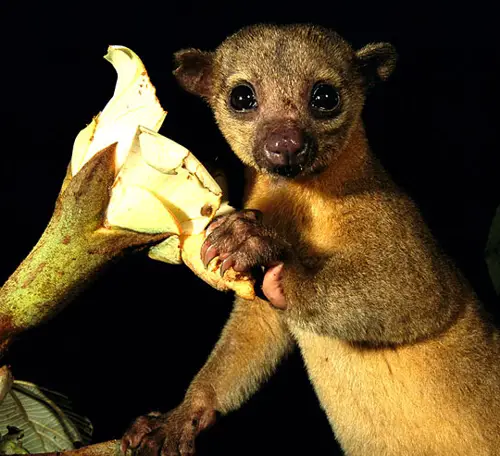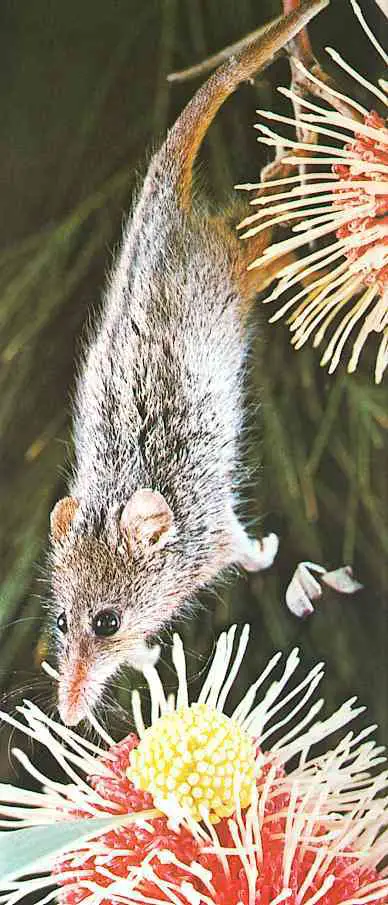Kinkajou
The Kinkajou lives in the subtropics or tropical rain forests, in Central and South America, where most of their life is spent in trees.
This is a lot easier for them than for many other animals as they have several quite interesting adaptations, one of which is an incredible tail, and the other being some very strange feet that can do things that might shock you if you saw it.

A kinkajou holding a Balsa blossom
The kinkajou can turn its feet backwards, to run quite easily in either direction up a branch or up and down a tree trunk
They also have whats called a prehensile tail, which means that it can grip easily and they use it like a third arm, to hang onto anything they’d like to grip onto. This incredible tail helps the kinkajou hang, balance and also covers them very much like a warm blanket while they are sleeping very high up in what is called the canopy part of the tree tops.
Although many people think its a lot like a monkey or a primate, the kinkajou is really very closely related to the raccoon family of North America.
The Kinkajou has the nickname of Honey Bear, because a big part of its food source is gained by raiding the nests of honey bees. The Kinkajous have a long skinny tongue that they use to lick honey from the hive and also to lick up insects, such as ants and termites, which they remove from their nests.
Kinkajous omnivores, eating meat, fruit and insects, selecting smaller mammals that they grab with the quick front feet, that have some very sharp claws attached. They hunt and eat at night, being nocturnal and in the morning they return to the same tree where they will sleep in tree holes they’ve made.
Every summer the female Kinkajou will give birth to one baby, which is born with its eyes closed, blind for over a month, but a baby that grows and develops so fast that by the end of the second month, it can hang from its own tail upside down.
Kinkajous live in large family groups up in the very highest part of the tree tops, called the canopy, and share life, including grooming each other and interacting in a social way.
Although they aren’t seen very often, being secretive creatures, they are always heard, as they screech and bark nearly all the time.



I really needed help on a compare and contrast essay on two animals, the kinkajou and the sugar glider. I needed a important fact on the kinkajou and I found it thanks for this great website. I really love animals and I love this website!
I LOVE kinakajous, they are such a cute animal. I am researching on this website because I am doing a project for school. This website has a lot of information!
I love kinkajous so much and I want one as a pet, theres just one problem. Kinkajous are illegal pets in California. :( I want to move somewhere else but its not up to me because I’m only 11 years old. This will sound like a silly question but if there’s anything you can do do it so I can have a kinkajou as a pet. I’ll be very happy if you can. :)
good description
I AM AN ANIMAL ENTHUSIAST AND I WOULD LIKE TO EXPRESS ON MY APPRECIATION TO THIS WONDERFUL SITE
This is a weird looking thing. But also kinda cute… My nieces think that they are aWESOME!
kinkajous’ are so cute!! i think that anyone that wants a kink should go for it. i would love to learn more about them.
this animal is so cute i want one as a pet!
i believe its known as the honey bear not the honey badger
Hi im ashley sirois your so right about them being cute.And im also researching them in school. i got alot of info on all of the websites.
i really needed that for my book report! thanks.
kinkajous are so adorable and im using this website because im doing a project about them!
my kinkajou project is overdue i totally forgot about it :o
This website is so informational.
Kinkajous are VERY dangerous because can be vicious and have very sharp teeth. I was badly bitten by one on my arm. It wouldn’t stop biting me and my friend had to get a hose and spray it with water to get it to stop. Do not consider a wild animal for a pet.
love em im doin my project on em
heeyyy guys ummmmm quik question who made this site…
Doing Extra Credit on them now
i love my kinkajou missy ! she is a sweetheart! best decision i’ve ever made,she is part of our family and will be for a while since they live so long. they are pretty amazing creatures. its was interesting studying up on them before i decided to get one.